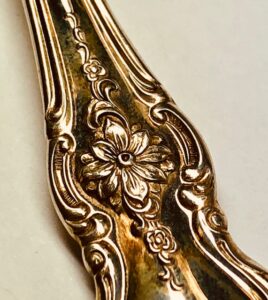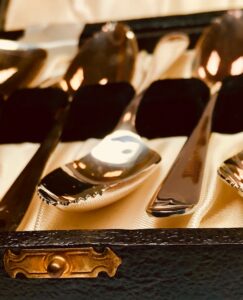 Sterling silver is a ubiquitous precious metal that can be found within almost every estate, most commonly in antique jewelry, hollow ware, and flatware. Hollow ware refers to larger kitchen items such as dishes, trays, bowls, cups, etc. Flatware is of course the utensils everyone is familiar with (forks, knives, spoons). When it comes to collectible sterling, the most important factors when determining value are the manufacturer and the pattern. There are hundreds of different silversmiths, and each of these with their own collection of ornate patterns, some more rare than others. Wallace, Gorham, Reed & Barton, and Lunt are just a few of the highly regarded names in the sterling market. The Grand Baroque pattern from Wallace Silversmiths is one of the most highly sought-after patterns there is, making it worth more than some of their other patterns, suh as the Continental Classic. Every manufacturer has their own unique signature inscribed somewhere on the back of the piece, which makes identifying your sterling quite simple, and even enjoyable. Additionally, there are numerous online databases with information on every pattern and its maker, to provide you with everything you need to know about your pieces.
Sterling silver is a ubiquitous precious metal that can be found within almost every estate, most commonly in antique jewelry, hollow ware, and flatware. Hollow ware refers to larger kitchen items such as dishes, trays, bowls, cups, etc. Flatware is of course the utensils everyone is familiar with (forks, knives, spoons). When it comes to collectible sterling, the most important factors when determining value are the manufacturer and the pattern. There are hundreds of different silversmiths, and each of these with their own collection of ornate patterns, some more rare than others. Wallace, Gorham, Reed & Barton, and Lunt are just a few of the highly regarded names in the sterling market. The Grand Baroque pattern from Wallace Silversmiths is one of the most highly sought-after patterns there is, making it worth more than some of their other patterns, suh as the Continental Classic. Every manufacturer has their own unique signature inscribed somewhere on the back of the piece, which makes identifying your sterling quite simple, and even enjoyable. Additionally, there are numerous online databases with information on every pattern and its maker, to provide you with everything you need to know about your pieces.  However, in most cases it is both impractical and inconvenient for someone facing all of the other responsibilities of an estate liquidation to deal with these details, and that's why the Southern Estate Brokers team is here to handle these little things for you. Researching vintage sterling is second nature to us, and moving it into the hands of buyers is our forte. Collectible sterling is always a hot ticket item at our estate sales and auctions, and if all else fails, we know the other appropriate avenues to take in order to turn your silver into cash.
However, in most cases it is both impractical and inconvenient for someone facing all of the other responsibilities of an estate liquidation to deal with these details, and that's why the Southern Estate Brokers team is here to handle these little things for you. Researching vintage sterling is second nature to us, and moving it into the hands of buyers is our forte. Collectible sterling is always a hot ticket item at our estate sales and auctions, and if all else fails, we know the other appropriate avenues to take in order to turn your silver into cash.